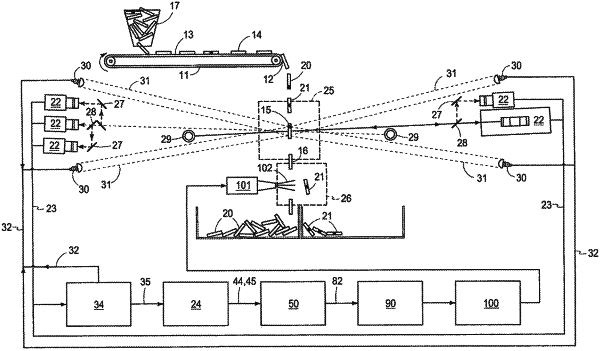| CPC B07C 5/3422 (2013.01) [B07C 5/366 (2013.01); G06F 18/251 (2023.01); G06V 10/245 (2022.01); G06V 10/25 (2022.01); G06V 10/255 (2022.01); G06V 20/52 (2022.01); B07C 2501/0018 (2013.01); B07C 2501/0081 (2013.01); G06T 2207/30128 (2013.01); G06V 20/68 (2022.01)] | 26 Claims |

|
1. An apparatus for sorting comprising:
a conveying device having a conveying surface, the conveying device being configured such that a product stream of individual objects of interest can be conveyed along the conveying surface, each of the individual objects of interest have features that are invisible to traditional optical detection, said features that are invisible to traditional optical detection are deemed acceptable or unacceptable for further processing;
an inspection station having a plurality of hyperspectral or multispectral image generating devices, the inspection station positioned relative to the conveying device such that the product stream passes through the inspection station, each of the plurality of hyperspectral or multispectral image generating devices is configured to generate a multiplicity of synchronized image signals of the individual objects of interest, each of the multiplicity of synchronized image signals having discreet signal features, and wherein the multiplicity of synchronized image signals represent the individual objects of interest traveling in the product stream;
wherein the multiplicity of synchronized image signals are combined by selective synchronization of the hyperspectral or multispectral image generating devices to generate a multiplicity of fused image and sensor signals, and a spatial resolution of each of the individual objects of interest travelling in the product stream is generated by utilizing a known position, orientation, and an operational response of each of the hyperspectral or multispectral image generating devices, and to further align the discrete signal features of each of the multiplicity of synchronized image signals;
a controller that implements a plurality of control functions, said plurality of control functions includes a first control function to predict the presence of acceptable and unacceptable characteristics in the individual objects of interest in the product stream by applying an image model to the multiplicity of fused image and sensor signals, to facilitate formation of an object presence image signal, and to facilitate formation of a defect image signal, the image model is formed from a multiplicity of previously acquired synchronized image signals from individual objects of interest having acceptable characteristics and aspects, and from individual objects of interest having unacceptable characteristics and aspects that include features that are invisible to traditional optical detection,
said plurality of control functions includes a second control function to identify individual objects of interest travelling in the product stream as being an acceptable object of interest or as being an unacceptable object of interest, by identifying one or more of a group of pixels in each of the object presence image signals and defect image signals which identify objects of interest or defects;
wherein a spatial orientation and location of the identified individual objects of interest travelling in the product stream is determined by applying a prior source of knowledge of acceptable individual objects of interest characteristics and aspects and unacceptable individual objects of interest characteristics and aspects, to the object presence image signals and to the defect image signals;
wherein defects within the unacceptable individual objects of interest in the product stream are detected by applying a prior source of knowledge of unacceptable individual objects of interest characteristics and aspects relative to acceptable individual objects of interest characteristics and aspects to object images formed of the object presence image signals and the defect image signals;
wherein the image model is updated with additional and subsequently acquired object presence image signals and defect image signals;
wherein the position and location of the unacceptable individual objects of interest in the product stream are identified; and
said plurality of control functions includes a third control function which renders operational an ejector, and wherein the third control function is coupled in signal receiving relation relative to an unacceptable individual objects of interest defect image signal which is generated by the second control function, and which further renders the ejector operational to remove unacceptable individual objects of interest from the product stream.
|